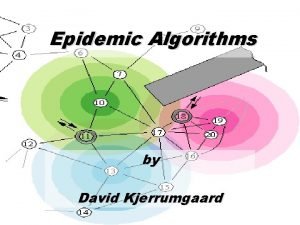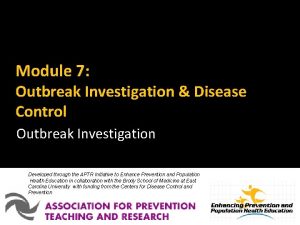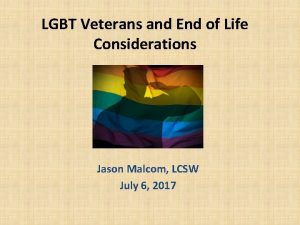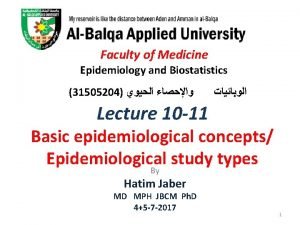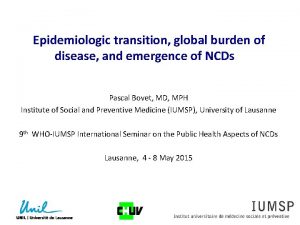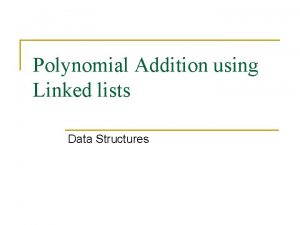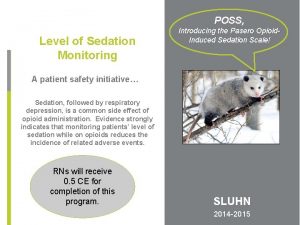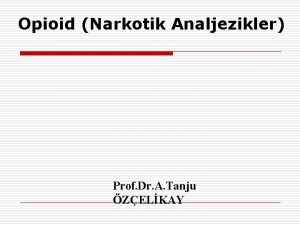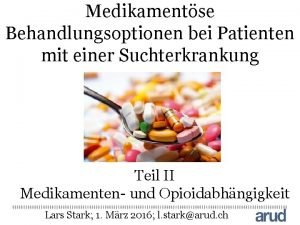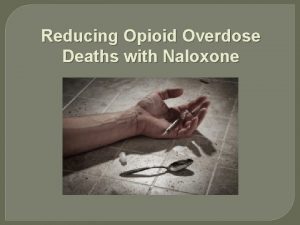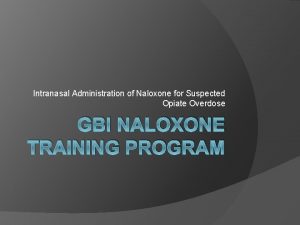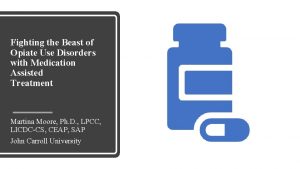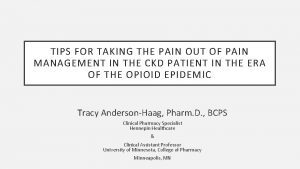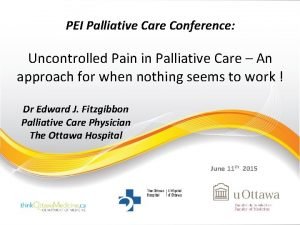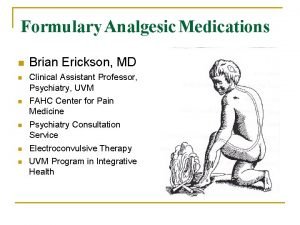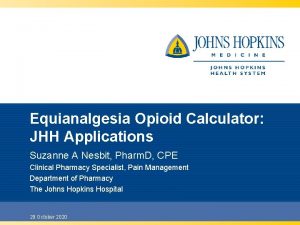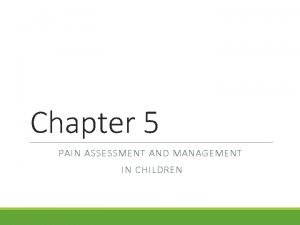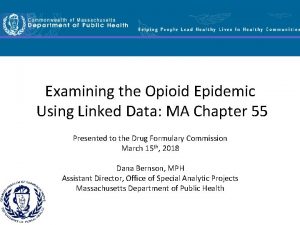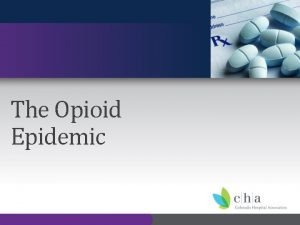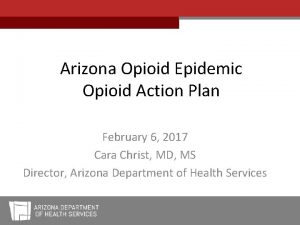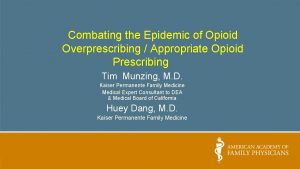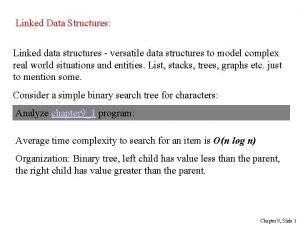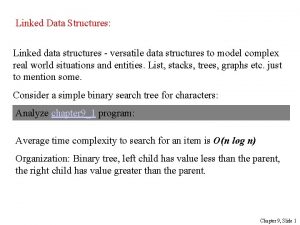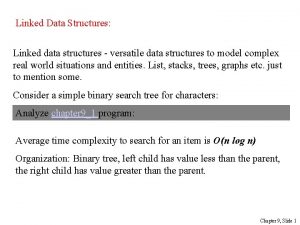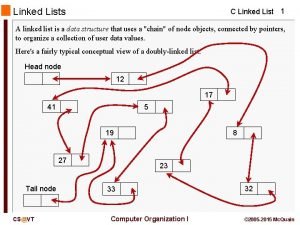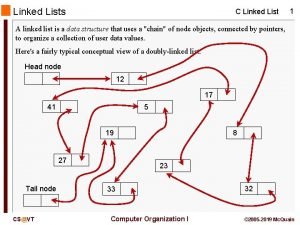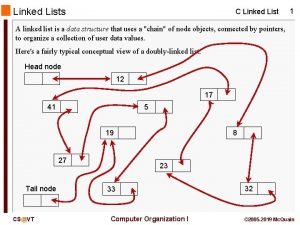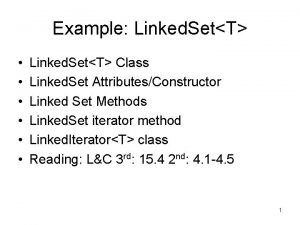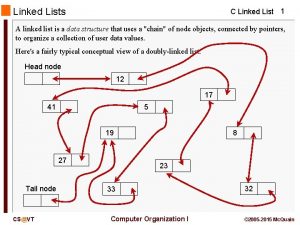Examining the Opioid Epidemic Using Linked Data MA


























- Slides: 26

Examining the Opioid Epidemic Using Linked Data: MA Chapter 55 Presented to the Drug Formulary Commission March 15 th, 2018 Dana Bernson, MPH Assistant Director, Office of Special Analytic Projects Massachusetts Department of Public Health

Outline • The opioid crisis in Massachusetts • Chapter 55 background • Chapter 55 results • Questions 2

The Opioid Crisis in Massachusetts 3

The Opioid Crisis in MA 1 Opioids include heroin, opioid-based prescription painkillers, and other unspecified opioids. 4

The Opioid Crisis in MA 5

Chapter 55 Background 6

Chapter 55: Legislative Mandate • Signed into law by Governor Baker in August 2015 • Provides the legal basis for cross-agency collaboration to study the alarming trends in opioid-related deaths • Specifies some contributing data partners • Overcomes legal barriers for use of some data • Required the MA DPH to examine data related to opioid overdose deaths and to submit report addressing 7 specific questions • DPH determined that questions could not be answered without linking the data sources 7

Chapter 55: Evolution • Phase 1: Look at fatal opioid-related overdoses. DPH answers 7 questions posed by legislature and conducts 4 additional analyses. Timeline: August 2015 - June 2016 • Phase 2: Expanded to included nonfatal opioid-related overdoses. DPH conducts several analyses and approves over 20 projects with external collaborators. Timeline: July 2016 -June 2017 • Phase 3: Expanded to “population health trends”. DPH to produce reports every 2 years. Timeline: July 2017 - ? ? ? 8

Chapter 55: Phase 2 Data Structure Chapter 55 Data Structure Data Sources Public Health Medical Claims & Hospital Mass. Health (Medicaid) Mental Health Public Safety Jails & Prisons DHCD (Homelessness) Veterans’ Services Service Flags Aggregate Community Level Data I. C. E. Measures NARCAN Enrollment NARCAN Refills NARCAN Rescues PDMP BSAS Treatment Toxicology Death Records OCME Intake MATRIS (EMS) State Police Heroin Birth Records MA Prisons Cancer Registry APCD Spine • • Service Indicator Flags MA Jails Medical Claims Dept Dev Services Mass. Health Youth Services Hospital and ED First Responder NARCAN Veterans’ Services DMH Transitional Assistance Children & Families Town & Zip Census Data Drug Seizure Data • • • System Attributes Linkage at individual level Longitudinal (5 years) Data encrypted in transit & at rest Limited datasets, unlinked at rest Linking and analytics “on the fly” No residual files after query completed Analysts can’t see data Automatic cell suppression Commission for Blind DHCD 9

Chapter 55 Results 10

Estimation of the Prevalence of Opioid Use Disorder (OUD) in Massachusetts, 2011 -2015 • Motivation: – Poor quality data on OUD prevalence – Unclear relative contribution of increasing OUD prevalence versus increasing mortality to increasing death rates • Objective: – Estimate the annual prevalence of OUD in Massachusetts from 2011 -2015 using a capture -recapture analysis 11

Estimation of the Prevalence of Opioid Use Disorder (OUD) in Massachusetts, 2011 -2015 • Methods – Identified markers of opioid use disorder (OUD) in seven databases: • All payer claims: Diagnosis of OUD • PMP: OUD treatment with buprenorphine • BSAS: Opioid detoxification, methadone or other OUD treatment • Ambulance encounter: nonfatal opioid overdose • Hospital encounter: nonfatal opioid overdose • Birth records: mothers of infants with neonatal abstinence syndrome • Death records: fatal opioid overdose 12

Estimation of the Prevalence of Opioid Use Disorder (OUD) in Massachusetts, 2011 -2015 • Methods (continued) – Contingency tables for each permutation of capture among seven datasets • Stratified by year, age, gender, and county – Multivariable models to estimate “unknown” population • Log-linear models with interaction terms to account for lack of independence among datasets 13

Estimation of the Prevalence of Opioid Use Disorder (OUD) in Massachusetts, 2011 -2015 Prevalence of OUD by Year Known 5% Unknown e creas n i % 9 5 4% 3% 2% 1% 0% 2011 2012 2013 2014 2015 14

Estimation of the Prevalence of Opioid Use Disorder (OUD) in Massachusetts, 2011 -2015 Prevalence of OUD by Year – 11 -25 years of age Known Unknown 2. 0% 1. 5% % 339 1. 0% se a e cr in 0. 5% 0. 0% 2011 2012 2013 2014 2015 15

Estimating the Number of Nonfatal Overdoses (NFO) • Motivation: – Some research has estimated that there are 20 nonfatal opioid-related overdoses (NFO) for every fatal overdose. This estimate predates the influx of fentanyl into the drug supply system. • Objective: – Estimate the annual incident of NFO in Massachusetts from 2011 -2015 using linked datasets and statistical modeling 16

Estimating the Number of Nonfatal Overdoses (NFO) • Methods – Overdoses captured in EMS and Case Mix data – need to link to de-duplicate in instance were EMS transported OD to the ED – These need to be linked to deaths to ensure that the OD was not fatal – DPH’s Bureau of Substance Abuse Services tracks some overdose reversals by community, which may not have had EMS or hospital involvement – All sources of data were used to develop a model of NFO that yielded a statistically reliable annual estimate of events in the state. 17

Estimating the Number of Nonfatal Overdoses (NFO) 18

Overdoses on Prescribed Opioids in Massachusetts, 2013 -2015 • Motivation: – Fatal opioid overdoses commonly attributed to prescribed opioids – Little data to support prescribed opioids as cause of overdose death • Objective: – Determine the proportion of opioid decedents: • with opioid prescriptions prior to death • with an active prescription for each opioid identified in postmortem toxicology 19

Overdoses on Prescribed Opioids in Massachusetts, 2013 -2015 • Methods – Cohort of 2, 916 opioid overdose decedents from 2013 -2015 with medical examiner toxicology data available. – Chapter 55 Data sources, individually linked : • Prescription monitoring program • State substance use treatment data • Vital statistics opioid-related death • Medical examiner toxicology 20

Overdoses on Prescribed Opioids in Massachusetts, 2013 -2015 Prescribed opioids at and prior to overdose death 70% 60% 50% 40% 30% 58% 20% 45% 36% 10% 27% 21% 17% 0% 1 year 6 months 3 months 1 month 1 week 1% At Death All opioids in tox prescribed Opioid prescribed in lookback period prior to death 21

Overdoses on Prescribed Opioids in Massachusetts, 2013 -2015 Opioids present in toxicology at death (n=2, 916) Active Rx on day of death: • Fentanyl – 1% • Oxycodone – 21% 22

Overdoses on Prescribed Opioids in Massachusetts, 2013 -2015 Active opioid prescriptions at time of death for people with postmortem toxicology: substance in toxicology vs. not in toxicology Oxycodone (n=176) 52% Methadone MMT (n=112) 32% Buprenorphine (n=97) 58% Methadone RX (n=38) Substance in Tox 13% Tramdaol (n=23) 39% Morphine (n=20) 35% Hydryocodone (n=18) 44% Hydromorphone (n=17) Substance Not in Tox 59% 0 50 100 150 200 23

Opioid and benzodiazepine prescriptions before and after overdose % receiving medication 20% 15% 10% Rx Opioid 5% Any MOUD 0% -12 -9 -6 -3 0 3 6 Months from index overdose 9 12

Time from initial prescription to overdose death Average Survival Time For Those Who Died of Opioid Overdose was 36 Months % Suviving of Those Who Died 100 80 60 40 20 0 0 ------ Months from Initial Prescription ------ 60

Questions? Dana Bernson Assistant Director, Office of Special Analytic Projects Massachusetts Department of Public Health 617 -624 -5669 dana. bernson@state. ma. us 26
 Epidemic broadcast trees
Epidemic broadcast trees Epidemic dropsy
Epidemic dropsy Gondhli millet
Gondhli millet Doctors attributed the epidemic to the rampant
Doctors attributed the epidemic to the rampant Endemic epidemic
Endemic epidemic Aids epidemic
Aids epidemic Endemic epidemic
Endemic epidemic Epidemiological transition model
Epidemiological transition model Data preparing exploring examining and displaying
Data preparing exploring examining and displaying Singly linked list vs doubly linked list
Singly linked list vs doubly linked list Difference between an array and a linked list
Difference between an array and a linked list Pengertian single linked list
Pengertian single linked list Representation of polynomial using linked list
Representation of polynomial using linked list Polynomial addition using linked list in c
Polynomial addition using linked list in c Poss level
Poss level Aldolan ampul
Aldolan ampul Alprazolam äquivalenzdosis
Alprazolam äquivalenzdosis Opioid overdose
Opioid overdose Opioid overdose
Opioid overdose Opioid overdose
Opioid overdose Types of pain
Types of pain Mechanism of action of opioid analgesics
Mechanism of action of opioid analgesics What is pain
What is pain Opioid receptors location
Opioid receptors location Brian erickson md
Brian erickson md Opioid settlement calculator
Opioid settlement calculator Non-opioid
Non-opioid
